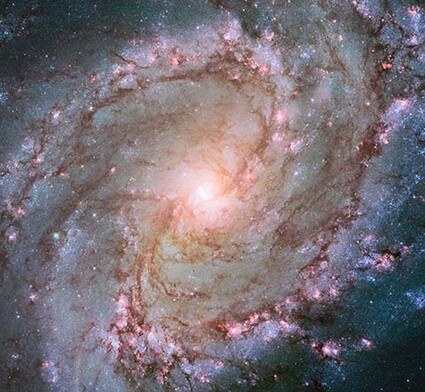Stars over Sisters 2/23/2021
Last updated 2/23/2021 at Noon

courtesy NASA
The Southern Pinwheel Galaxy is a bright galaxy that lies at a distance of 15 million light-years in the constellation of Hydra.
As the weather begins to warm, with spring just around the corner, March contains an abundance of astronomical offerings. Some of these include the zodiacal light, a four-bodied conjunction, and optimal views of the full supermoon — or is it?
But up first is a profile of the early spring constellation of Hydra.
Hydra, the Water Serpent, is the largest, occupying an area of 1,303 square degrees, and longest of the 88 modern constellations. Except for its head, this grouping of stars lies in the southern celestial hemisphere. In fact, from our latitude most of the serpent’s stars lie about 15 to 20 degrees above the southern horizon.
Although the constellation is quite large, its constituent stars are not very bright. Alphard is the brightest luminary shining at a magnitude of 2.0. It’s classified as an orange giant believed to be only 420 million years old, with three times the mass of the sun, lying approximately 177 light-years from Earth. The northern-most portion of Hydra (its head) is easy to spot. Look for it well up in the southeastern sky at about 8 p.m. early in March.
Like most other constellations, Hydra is home to several deep sky objects, three of which hold Messier designations. The most impressive of these bodies is unquestionably the magnificent galaxy M83. Dubbed the Southern Pinwheel Galaxy because of its distinctive spiral shape, this bright object is about 55,000 light-years in diameter and lies some 15 million light-years from Earth. Under ideally dark skies, this galaxy can be seen using binoculars.
In Greek mythology Hydra is known as Lernaean Hydra, the nine-headed water serpent that Hercules was sent to kill as one of his twelve tasks given to him by Hera, wife of Zeus. But since just one of the serpent’s heads was said to be immortal, the constellation is depicted with a single head.
Spring arrives in the Northern Hemisphere on Saturday March 20, at 2:37 a.m. PDT. At that time, the sun will cross the celestial equator and enter the northern celestial hemisphere from the south. When this happens, the duration of both night and day will be nearly the same.
When dusk has faded from the western horizon this time of year, look for a faint pyramid-shaped glow extending from the horizon into the sky. Called the Zodiac Light, it’s caused by debris left over from inner planetary formation scattering sunlight. The spectacle is best seen in the spring, because the ecliptic makes a steep angle with the western horizon.
Most of the planetary action in March takes place in the morning sky. Early in the month Jupiter, Mercury, and Saturn begin to congregate in the southeast about 30 minutes before sunrise. Then, on March 10, a slender 26-day-old crescent moon joins the trio, making for a most picturesque four-bodied conjunction!
Mars remains the brightest planetary sentinel in the evening sky, as it treks eastward through Taurus. Uranus is nearby too and can be seen in Aries just below the bright star Hamal by using binoculars. Venus is lost in the sun’s glare all month.
On March 28, the Full Worm Moon arrives on the scene. That much is certain. But will it be a full supermoon? Because the term “supermoon” lacks a precise definition, it may depend on who you ask. Sky and Telescope magazine seems to back a simple, straight-forward meaning: Any full moon that comes within 223,000 miles of Earth is a supermoon. Another version requires the moon to be within 90 percent of its closest approach to Earth (perigee) in a lunar cycle. A third approach does something similar but uses the closest perigee within a particular calendar year.
Applying these methods to this month’s full moon, only one of them declares it a supermoon.
















Reader Comments(0)